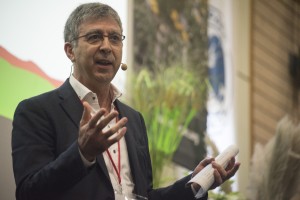Protected Areas. Isn’t that old-fashioned?
The Swiss National Park was the second Park being created in Europe, in 1914 © Swiss National Park Archive
Article issued by Carlos Romão
extracted from EUROPARC Journal Protected Areas In-Sight 2016

Photo from EUROPARC Spain Archive
Once upon a time… England, the 11th century, William (The Conqueror) created several ‘protected areas’ with the purpose of preserving game and forests, among them what is now the New Forest National Park. These are some of the oldest records in Europe of defined areas with a special management and dedicated laws.
Since then, the values or their perception has changed over time reflecting cultural, social, economic and political contexts: tools to conserve a specific resource (timber, game), ‘monuments’ of natural beauty and for aesthetical reasons, threatened species and habitats, labs of sustainable development and promotion of local products, etc.
Protected Areas is Europe
The first state-owned national parks in Europe were created in 1909 in Sweden and 1914 in Switzerland, with a steep increase after the 1st World War. The first trans-border park was created in 1932, in the Pienniny Mountains of Poland and Slovakia.
Between the 1970s and the 1990s, several of the international conventions on nature conservation included provisions for the creation or promotion of protected areas, including in the marine environment. Finally, the adoption of the EU Habitats Directive in 1992 gave birth to the Natura 2000 network.
Today, there are near 1.2 million square-kilometres of protected areas (almost the area of Spain, France and Germany); this is 21 % of the European terrestrial area and corresponds to 70 % of the records in the World Database of Protected Areas (from IUCN-UNEP).
The surface of protected areas doubled since the mid-1990s,
largely due to the creation of the Natura 2000 network. Currently, the network covers over 18 % of the terrestrial area and 6 % of the marine area.



Graphics extracted from Carlos Romao presentation at EUROPARC Conference 2016
However, most biodiversity indicators and studies on the state of nature are rather gloomy:
- near one-third of birds have a non-secure status (threatened, declining or depleted);
- 60% of non-avian species assessments and
- 77 % of habitats assessments from the Habitats Directive have an unfavourable-conservation status.
Moreover, the number of species and habitats further declining are much more than those improving; this indicates that we will most likely miss the EU 2020 biodiversity targets.
Does this mean protected areas are old-fashioned and they now have little value for conserving and restoring biodiversity?
Well, I have been fortunate to work and visit many protected areas in Europe and it is clear we see them working and delivering- not only for biodiversity, but also many of the cultural, social and economic services and values that motivated humans through-out history, to identify, protect and especially manage defined portions of land and sea. This perception is backed-up by numerous studies published in peer-review journals or available as grey literature.
Clearly, protected areas are the backbone of nature conservation, but this type of ‘protection regime’ is not sufficient to address the significant pressures on the European biodiversity, such as : semi-natural habitats and farmland-related species being lost by abandonment of agricultural practices or its intensification; large-scale modification of freshwater systems; pollution and unsustainable fishing at sea.
- semi-natural habitats and farmland-related species being lost by abandonment of agricultural practices or its intensification;
- large-scale modification of freshwater systems;
- pollution and unsustainable fishing at sea.
The clear local benefits of protected areas can only be multiplied through societal changes at local, regional, national, European and global levels.

Carlos de Oliveira Romao at EUROPARC Conference 2016, Parc Jura vaudois, Switzerland © Joao Romba
Carlos Romão is Project Manager specialised on Biodiversity and Ecosystems, at the European Environment Agency (EEA).
He has developed the first EU biodiversity baseline to support the EU biodiversity strategy to 2020, co-authored the first EEA report on protected areas and coordinated the EEA ‘State of Nature’ report. Currently, Carlos is working on reporting under the EU nature directives (Birds & Habitats) and on assessing conservation status of species and habitat types.
References
EEA, 2012, ‘Protected areas in Europe – an overview’, EEA Report No 5/2012.
EEA, 2015, ‘State of nature in the EU – results from reporting under the nature directives’, EEA Technical report No 2/2015.
Natura 2000, EEA, 2016
WDPA, Protected Planet, 2016